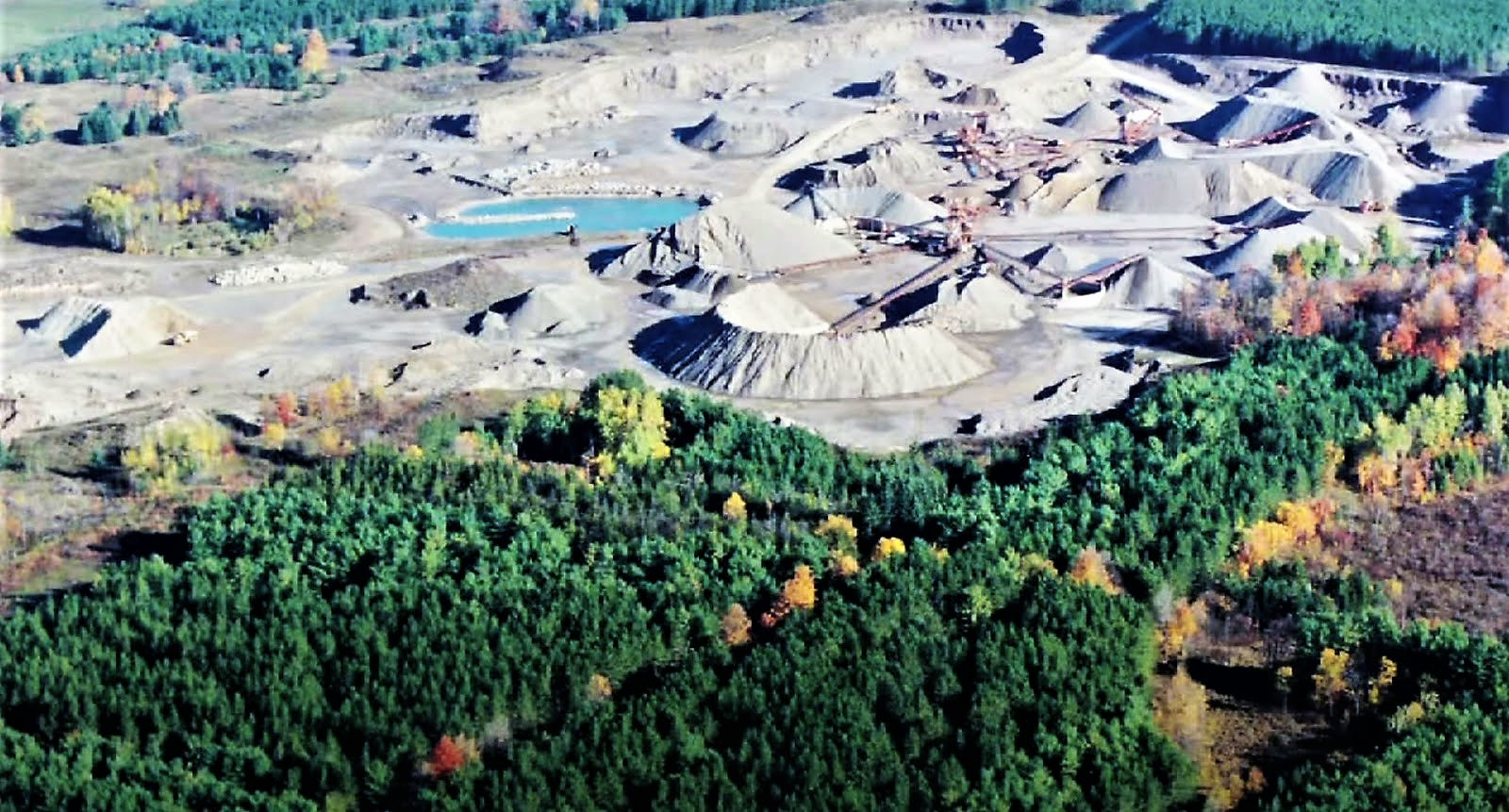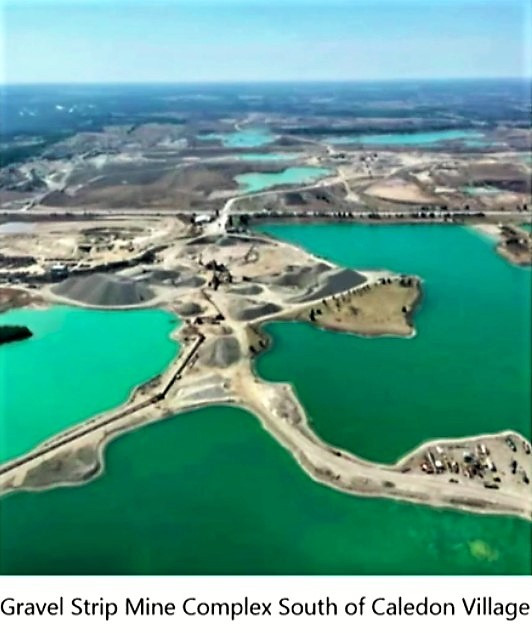
Joint review with Region suggests Caledon doing well on quarry policies, contrary to municipal report card
Residents and councillors clapped back at staff during a planning and development committee meeting Tuesday after a report suggested Caledon’s aggregate policies are in line with expectations.
The Joint Aggregate Policy Review was created at the Regional level, and both residents and committee members expressed concerns over how it described the aggregate industry in Caledon.
For decades, gravel pits, open wayside operations and quarries have been proliferating across Caledon’s previously untouched greenspaces and agricultural lands.

(Supplied)
Residents have grown frustrated over the destruction of the area’s sensitive ecosystems, the constant flow of large gravel trucks in and out of quarries and other pits and the poor land use that leaves entire swaths of the rural municipality pocked by gaping craters and large mounds of earth.
Work for the report was undertaken as part of the Region of Peel’s Official Plan review, also known as Peel 2051, with the intention to inform both the Region and Town of Caledon’s Official Plans. With the changes to regional responsibilities under the PC government’s ambitious Bill 23, to create 1.5 million homes across the province by 2031, and the looming break-up of Peel under the Hazel McCallion Act, the Region will no longer be proceeding with amendments to its Official Plan. Instead, the Joint Aggregate Policy Review, along with two other discussion papers — a High Potential Mineral Aggregate Resources Areas Mapping Methodology and a Transportation Technical Paper — were provided to the Town of Caledon as input for the review of its Official Plan and mineral aggregate resource policies and mapping.
“The Town Caledon has a very thorough set of aggregate policies, laying out in detail the tests that need to be met in considering new applications,” the review highlights as a key finding.
It was a statement David Sylvester, one of the delegates and the president of the Forks of the Credit Preservation Group (FCPG) who has been fighting the proposed 800-acre mega blasting quarry in Cataract, categorically disagreed with.
“I too found it somewhat unfamiliar with what we deal with, with pits and quarries here in Caledon,” added Ward 1 Councillor Lynn Kiernan.
Using nine criteria to rank the accountability in top aggregate producing municipalities in Ontario, Caledon is in dead last.
(TAPMO)
At a meeting hosted by the FCPG in September, registered planner Susan Robertson spoke about the Top Ten Aggregate Producing Municipalities in Ontario (TAPMO), an oversight collective of municipal governments and industry operators committed to developing standards and expectations for extraction across the province. While none of the 10 municipalities ranked in TAPMO’s performance scorecard did particularly well, Caledon is trailing far behind the rest in its policies and actions related to aggregate extraction. Each municipality was assessed based on nine criteria including air quality, blasting, cumulative effects, First Nations consultation, haul routes, hydrogeological impacts, natural heritage disruption, noise and surface water issues.
“Overall concerning aggregate extraction, Caledon had a general lack of policy context and a highly permissive policy context with minimal description tests and terminology,” the TAPMO report states.
The disturbing last place finish for Caledon is believed to be the reason that shortly after the September FCPG meeting, a special council meeting was convened on October 18, less than a week before the municipal election, to pass an Interim Control By-Law (ICBL) for one year that currently acts as a pause button for all new aggregate applications in the ICBL area — critics questioned if former councillor Jennifer Innis, who was running for mayor, only pushed the ICBL as an election ploy following years of blindly supporting controversial quarry and other aggregate applications. Innis faced widespread criticism during the election campaign. She had previously refused to support a motion by current Mayor Annette Groves who as a councillor last term tried to introduce accountability mechanisms for the powerful aggregate industry.
One of the stipulations under the ICBL that council decided on was to create an aggregate working group consisting of the mayor, the Ward 1-area councillor, the Ward 1, 2 and 3 Regional councillor, six residents and town staff. The purpose of the working group is to liaise with the community and bring a variety of independent perspectives to the study review process. The members of the oversight group were decided upon in late May and the work of the group is now beginning.
“I want to make sure that that's abundantly clear,” Antonietta Minichillo, director of planning and chief planner at the Town of Caledon, said during Tuesday’s meeting.
“We have identified as a community as a council that we're going to undertake a supplementary aggregate study, and that's going to be done in consultation with the working group on the lived experience, the human, the social elements.
“[The Joint Study] is a Region of Peel report that we've been undertaking together, but that we're going to supplement with the additional work that we're doing and the community working group, again, has been established to help in consultation with the development of those new policies.”
This map shows the areas of Caledon designated as high potential mineral aggregate resources areas. The additions and subtractions from these areas are what is being suggested to the Town by the Region of Peel.
(Town of Caledon)
There was a time when Caledon was ranked high for its aggregate policies, but with recent councils that have shown little interest in evolving their policies as the industry has become more aggressive, the Town quickly fell behind, leaving Caledon at the whim of powerful companies driven by large profits extracted from the natural landscape of the GTA’s largest municipality. Caledon’s current aggregate policies were developed in 1998 — a quarter of a century ago.
“Municipal governments have many responsibilities, including safeguarding the health and well being of its citizens. And planners have the explicit right to incorporate those safeguards into an Official Plan,” Sylvester said. “Regrettably, I see no evidence in this planning, report or discussion paper that these safeguards have been treated seriously.”
“I'm told that Caledon was the leader in our policies,” Keirnan added. “That was before my time. But we used to be apparently the leader in these policies, we are certainly not there anymore. Considering the constraints we're under, I would like to challenge everyone here to get that award, again, that we should be the leader in these policies.”
The issues residents and some councillors, as well as Mayor Groves, would like the Town to focus on include air quality, noise pollution, groundwater protection, transportation and traffic, and setback distances. While the province does have minimum setback distances, pits and quarries are exempt from these requirements and are commonly visible to area residents and anyone driving in areas where operations often extend right to property lines.
Mayor Groves has been working alongside the mayors of both Burlington and North Dumfries to enhance policies related to aggregate and has had multiple meetings with the Minister of Natural Resources and Forestry, Graydon Smith, to develop minimum setback distances for aggregate operations to protect sensitive receptors such as homes, schools and places of worship, while preventing gravel operations including quarries to overwhelm entire areas.
“We will be following up with the minister's office with the review that they're doing,” Groves assured. “And we're hoping and we were encouraged that they were taking all those things into consideration with respect to minimum separation distances.”
Along with the Joint Review, the Town of Caledon made public its plan for completing studies and reviews within the timeframe of the interim control bylaw, which expires in about four months and the mandated time frame of the working group.
The Town has hired consultant Mark Dorfman, who previously worked with Caledon when it fought the Rockfort Quarry, to oversee the process of analyzing the discussion papers and the development of the Town’s own policies based on its comprehensive studies.
It’s unclear if the glowing report from the Region of Peel, which was widely dismissed Tuesday, will inform future work.
The first meeting of the working group is set for the end of June.
Email: [email protected]
Twitter: @rachelnadia_
At a time when vital public information is needed by everyone, The Pointer has taken down our paywall on all stories relating to the pandemic and those of public interest to ensure every resident of Brampton and Mississauga has access to the facts. For those who are able, we encourage you to consider a subscription. This will help us report on important public interest issues the community needs to know about now more than ever. You can register for a 30-day free trial HERE. Thereafter, The Pointer will charge $10 a month and you can cancel any time right on the website. Thank you
Submit a correction about this story


